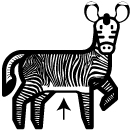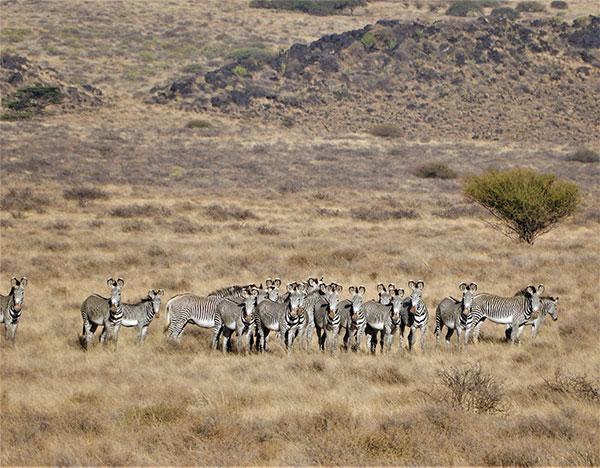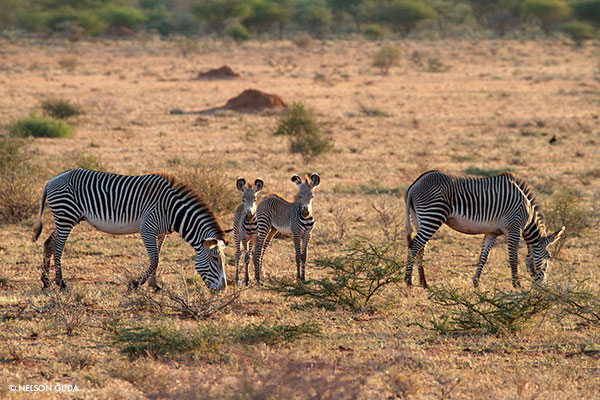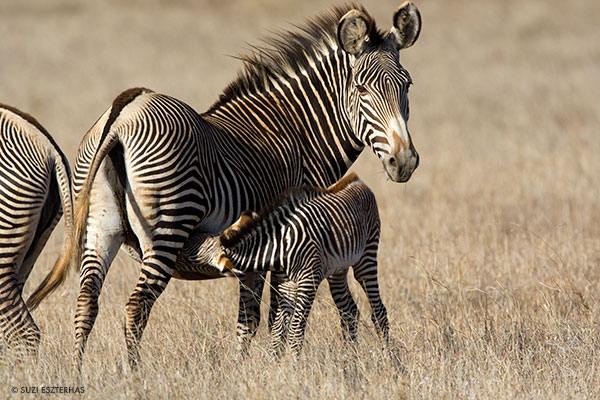© Gillian Knox
What’s The Difference?
Grevy’s zebra were the first of the zebra species to evolve after asses, as well as being the largest equid species.
There is also the more common plains zebra. These two species overlap in the southern range of Grevy’s zebra and the northern range of plains zebra.
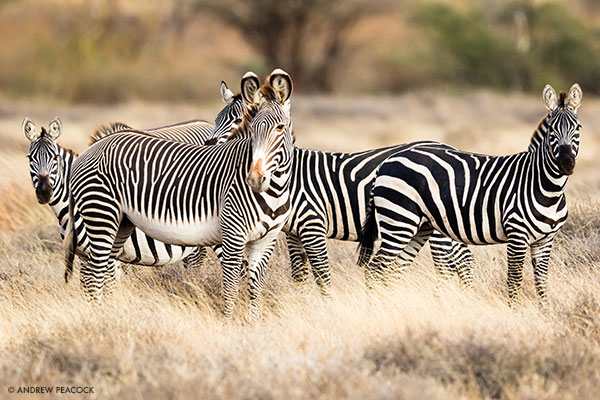
The Grevy’s zebra is easily distinguished from the plains zebra by these characteristics:
The Grevy’s zebra occupies the niche between the water-dependent plains zebra and the arid-adapted wild ass, living in arid and semi-arid habitat comprised of grass and shrubland with permanent water available. Predominantly grazers, Grevy’s zebra live on forbs and grasses but during extremely dry periods they also browse.
Grevy’s zebra can go without water for up to five days; however, if lactating, the females must drink at least every other day in order to maintain milk production. With land degradation worsening each year, the distance between available grazing and water increases, meaning that Grevy’s zebra mothers have to make long and more frequent journeys to drink, resulting in high foal mortality, which is one of the major threats to the survival of the species.
Closer to an ass than a horse, the Grevy’s zebra social system is adapted to their arid and semi-arid ecosystem. Breeding males reign over territories averaging 6km² in size, which they have established with the interests of the females in mind: water, forage, and the strength and power of the male to watch out for her safety. Grevy’s zebra males that have not yet reached sexual maturity are found in bachelor herds. A territorial male can keep his territory for up to seven years before he will be defeated by a younger, stronger bachelor male who will challenge him for the territory. Males make the boundaries of their territories known by vocalising loudly and by creating dung piles which they mark regularly to let everyone know they are present.
Depending on her breeding condition, a female Grevy’s zebra has different resource requirements. When she is lactating, she needs to be closer to water and therefore those males that have water within their territory will be more successful at breeding. Only if females are not in breeding season within a territory, will the bachelors be tolerated by the dominant territorial male. Home ranges are huge, and can measure up to several hundred square kilometers in a year, as females and bachelor males follow forage and water availability.
Females achieve sexual maturity around 3 years of age and males achieve sexual maturity around 6 years of age. Besides the thrill one gets when seeing young foals in a herd, it is also an encouraging sign, and indicative of a healthy population. Grevy’s zebra females are generally found together with other females in similar stages of reproduction. Their gestation period is 13 months, after which one foal is born, all gangly long legs and big fuzzy ears. After foaling, the mothers are solitary for a few days before joining other females with their foals. Grevy’s zebra foals begin life by learning to distinguish their mother within the herd, gambolling, exploring and, finally, getting to know their peers.
When lactating, Grevy’s zebra’s water requirements are high. As foals do not drink water before four months of age, they are fully dependant on their mother’s milk until then. Foal survival is highest when lactating mares have immediate access to safe water sources as they do not need to leave their foals for long periods, nor do the foals have to follow their mothers across a potentially dangerous landscape. Generally, foals follow their mothers from within a few hours after birth until weaning at 10 months.
In protected areas, such as Lewa Wildlife Conservancy, Grevy’s zebra form nursery (or kindergarten) herds, whereby foals will be left in a group with one or more adults guarding the herd, while their mothers travel to water.
By forming groups with other females and foals, the mother provides her foal with an opportunity to interact with its cohorts. When conditions are good, foals are able to engage in play bouts, with the motor actions involved in play being similar to those needed for fighting and escaping predation. In addition, mothers benefit from being in groups with other foals as the probability of detecting predators is increased while the probability of her foal being preyed upon is reduced.




